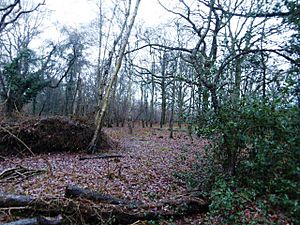Wykery Copse facts for kids
| Site of Special Scientific Interest | |
 |
|
| Area of Search | Berkshire |
|---|---|
| Interest | Biological |
| Area | 3.2 hectares (7.9 acres) |
| Notification | 1984 |
| Location map | Magic Map |
Wykery Copse is a special natural area, about the size of five football fields (3.2 hectares or 7.9 acres), located west of Bracknell in Berkshire, England. It's officially called a Site of Special Scientific Interest (SSSI) because it's home to many important plants and animals. This means it's protected to keep its natural environment healthy and thriving.
Contents
Visiting Wykery Copse
As of late 2019, Wykery Copse was temporarily closed to visitors. This was because some of the wooden walkways, called boardwalks, were damaged. Boardwalks help people explore wet or sensitive areas without harming the plants or getting muddy. They needed to be fixed before people could safely visit again.
Amazing Plants of Wykery Copse
Wykery Copse is a fantastic place for plants! It has a wide variety of trees and smaller plants that make up its unique ecosystem.
Trees You Might See
The copse is filled with many different kinds of trees, each playing an important role. Here are some of the trees that grow there:
- Birch: Known for its papery bark.
- Alder: Often found near water.
- Ash: A common tree in British woodlands.
- Maple: Trees that often have distinctive leaves.
- Oak: A very strong and long-lived tree.
- Hazel: Often grows in thickets.
- Ulmus minor 'Atinia': A type of elm tree.
- Wild Service Tree: A rarer tree with interesting leaves.
- Wild Cherry: Produces small, edible cherries.
- Rowan: Also known as mountain ash, with bright red berries.
- Holly: An evergreen tree with spiky leaves.
- Crack Willow: A type of willow tree.
- Grey Willow: Another common willow.
- Aspen: Known for its leaves that tremble in the breeze.
- Crab Apple: Produces small, tart apples.
- Black Poplar Hybrid: A fast-growing poplar.
- Blackthorn: Has sharp thorns and produces sloe berries.
- Hawthorn: A thorny tree with white flowers.
- Dogwood: Known for its colorful stems.
- Turkey Oak: A type of oak with distinctive acorns.
Smaller Plants and Flowers
Besides the tall trees, Wykery Copse also has a rich collection of smaller plants and beautiful flowers growing on the woodland floor. These plants add to the beauty and biodiversity of the area.
- Honeysuckle: A climbing plant with sweet-smelling flowers.
- Redcurrant: A bush that produces small, red berries.
- Guelder-rose: Has white flowers and red berries.
- Bluebell: Famous for its carpets of blue flowers in spring.
- Thin-spiked Wood-sedge: A type of grass-like plant.
- Pale Sedge: Another sedge species.
- Early Purple Orchid: A beautiful wild orchid.
- Wood Anemone: Delicate white flowers that bloom early in spring.
- Pignut: A plant with an edible underground tuber.
- Yellow Archangel: Has yellow flowers and often forms a carpet.
- Yellow Pimpernel: A small plant with bright yellow flowers.
- Wood Sorrel: Has clover-like leaves and white flowers.
- Primrose: One of the first flowers to appear in spring.
- Common Figwort: A plant with unusual, greenish-brown flowers.
- Wood Speedwell: A small plant with blue flowers.
- Wood Melick: A type of grass found in woodlands.
- Wood Millet: Another woodland grass.
- Hairy-brome: A tall grass species.
- Cypress-leaved Plait-moss: A common moss found on trees and rocks.

